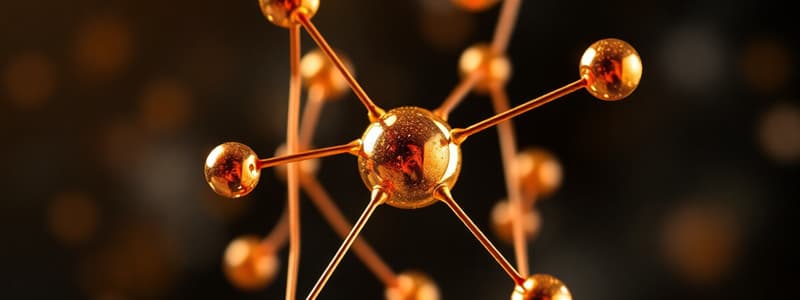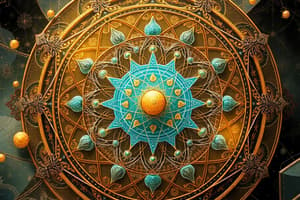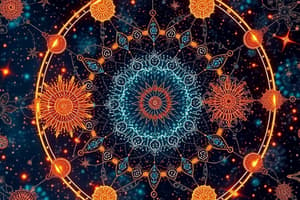Podcast
Questions and Answers
Which of the following is a fundamental particle found in an atom?
Which of the following is a fundamental particle found in an atom?
- Proton (correct)
- Molecule
- Cell
- Compound
The nucleus of an atom is negatively charged.
The nucleus of an atom is negatively charged.
False (B)
What is the charge of an electron?
What is the charge of an electron?
Negative
The number of protons in an atom is called the ________ number.
The number of protons in an atom is called the ________ number.
Match the particle with its charge:
Match the particle with its charge:
What particles are used in the Bohr model?
What particles are used in the Bohr model?
Electrons occur on shells at equal distances from the nucleus.
Electrons occur on shells at equal distances from the nucleus.
What charge does a nucleus have?
What charge does a nucleus have?
The number of protons and neutrons in the nucleus of an atom is called the ________ number.
The number of protons and neutrons in the nucleus of an atom is called the ________ number.
Match the charge with the correct particle:
Match the charge with the correct particle:
What does the proton number identify?
What does the proton number identify?
If a particle is neutral, the number of electrons is greater than the number of protons.
If a particle is neutral, the number of electrons is greater than the number of protons.
What is another name for the proton number?
What is another name for the proton number?
If a particle is positively charged, it's a _________.
If a particle is positively charged, it's a _________.
Match positively and negatively charged particles
Match positively and negatively charged particles
What are isotopes?
What are isotopes?
Relative isotopic mass is relative to 1/24 the mass of a carbon-12 atom.
Relative isotopic mass is relative to 1/24 the mass of a carbon-12 atom.
What is the abbreviation for relative atomic mass?
What is the abbreviation for relative atomic mass?
The weighted mean of the atomic masses of the atoms of a particular element relative to 1/12 the mass of carbon-12 atoms is called _________.
The weighted mean of the atomic masses of the atoms of a particular element relative to 1/12 the mass of carbon-12 atoms is called _________.
Show how isotopes are related to elements and numbers of protons and neutrons
Show how isotopes are related to elements and numbers of protons and neutrons
What type of energy do gamma rays have?
What type of energy do gamma rays have?
An alpha particle is composed of an electron.
An alpha particle is composed of an electron.
What is a beta particle composed of?
What is a beta particle composed of?
Radioactive decay is a process by which ___________ lose energy.
Radioactive decay is a process by which ___________ lose energy.
Match the correct half-life definition:
Match the correct half-life definition:
What is the maximum number of electrons an s subshell can hold?
What is the maximum number of electrons an s subshell can hold?
Each orbital can hold a maximum of 4 electrons.
Each orbital can hold a maximum of 4 electrons.
What shape is an S-orbital?
What shape is an S-orbital?
A p-subshell consists of _________ dumbbell-shaped orbitals.
A p-subshell consists of _________ dumbbell-shaped orbitals.
Match the subshells
Match the subshells
Flashcards
What are protons?
What are protons?
Positively charged particles located in the nucleus.
What are neutrons?
What are neutrons?
Electrically neutral particles located in the nucleus.
What are electrons?
What are electrons?
Negatively charged particles orbiting the nucleus.
What is the Bohr model?
What is the Bohr model?
Signup and view all the flashcards
What is the proton number?
What is the proton number?
Signup and view all the flashcards
What is the nucleon number?
What is the nucleon number?
Signup and view all the flashcards
What is the electron number?
What is the electron number?
Signup and view all the flashcards
What is an ion?
What is an ion?
Signup and view all the flashcards
What are isotopes?
What are isotopes?
Signup and view all the flashcards
What is relative isotopic mass?
What is relative isotopic mass?
Signup and view all the flashcards
What is relative atomic mass (RAM)?
What is relative atomic mass (RAM)?
Signup and view all the flashcards
What is radioactive decay?
What is radioactive decay?
Signup and view all the flashcards
What is an alpha particle?
What is an alpha particle?
Signup and view all the flashcards
What is a beta particle?
What is a beta particle?
Signup and view all the flashcards
What are gamma rays?
What are gamma rays?
Signup and view all the flashcards
What is half-life?
What is half-life?
Signup and view all the flashcards
What is carbon-14 decay?
What is carbon-14 decay?
Signup and view all the flashcards
What is carbon dating?
What is carbon dating?
Signup and view all the flashcards
What are balanced nuclear equations?
What are balanced nuclear equations?
Signup and view all the flashcards
What is electronic configuration?
What is electronic configuration?
Signup and view all the flashcards
What is an atomic orbital?
What is an atomic orbital?
Signup and view all the flashcards
What shape is an s-orbital?
What shape is an s-orbital?
Signup and view all the flashcards
What shape is a p-orbital?
What shape is a p-orbital?
Signup and view all the flashcards
What is hybridisation?
What is hybridisation?
Signup and view all the flashcards
What is ionisation energy?
What is ionisation energy?
Signup and view all the flashcards
What is shielding?
What is shielding?
Signup and view all the flashcards
What is electron affinity?
What is electron affinity?
Signup and view all the flashcards
What is the periodic table?
What is the periodic table?
Signup and view all the flashcards
What are groups in the periodic table?
What are groups in the periodic table?
Signup and view all the flashcards
What are periods in the periodic table?
What are periods in the periodic table?
Signup and view all the flashcards
Study Notes
Fundamental Particles
- Atoms consist of positively charged nuclei surrounded by negatively charged electrons in shells
- The Bohr model can represent the structure of an atom using fundamental particles
Charges and Relative Weights of Fundamental Particles
- Protons have a positive charge
- Neutrons have a neutral charge
- Electrons have a negative charge
Atomic Number
- Indicates the number of protons in the nucleus of an atom
- Identifies an element
Nucleon Number
- Mass number which shows the number of protons and the number of neutrons in the nucleus of an atom
Electron Number
- The number of electrons in an atom or ion
- In a neutral atom, the number of electrons equals number of protons
- In a cation (positively charged ion), the number of electrons is less than number of protons
- In an anion (negatively charged ion), the number of electrons is greater than number of protons
Isotopes
- Particles of the same element that have the same number of protons, but different mass numbers due to different numbers of neutrons
Relative Isotopic Mass
- The mass of an atom of an isotope relative to 1/12 the mass of a carbon-12 atom
Relative Atomic Mass
- RAM is the weighted mean of the atomic masses of the atoms of a particular element relative to 1/12 the mass of carbon-12 atoms
- Chlorine-35 and chlorine-37 occur as isotopes with a 3:1 ratio, making relative atomic mass of chlorine is 35.5
- Bromine-79 and bromine-81 occur as isotopes with a 1:1 ratio, so the RAM of bromine is 80
- Copper-63 has a 69.2% relative abundance and Copper-65 has a 30.8% relative abundance so the relative atomic mass of copper is 63.6
- Magnesium-24 has 79.0%, Magnesium-25 has 10.0%, and Magnesium-26 has 11.0% abundance and the RAM of magnesium is 24.3
- Boron-10 and Boron-11 occur as isotopes with a ratio of 1:4, so the relative atomic mass of Boron is 10.8
- Chromium has four isotopes, Cr-50, Cr-52, Cr-53, and Cr-54, which occur at a ratio of 2:35:4:1, with a RAM of 52
- Gallium-69 and Gallium-71, the RAM of gallium is 69.7 and the relative abundance of each isotope is 0.65 : 0.35
- Potassium-39 and potassium-41, find the RAM of potassium is 39.1 and the relative abundance is 0.95 : 0.05
Isotopes as Tracers
- Oxygen has two isotopes, oxygen-16, the most common isotope, and oxygen-18
- Carboxylic acid can be produced to contain only oxygen-16 and alcohol produced to contain only oxygen-18
- Carboxylic acid and alcohol react using an H+ catalyst
- Products are collected where their Relative Molecular Mass is measured using mass spectroscopy
- Products include ethyl ethanoate (RMM of 90) and water (RMM of 18)
- Oxygen-18 from the alcohol becomes part of the ester
- Alcohol loses a hydrogen as the O-H bond breaks
- Carboxylic acid loses an OH as the C-O bond breaks
- The H and OH lost will form water, while an ester is produced
Radioactivity
- Radioactive decay involves nuclei losing energy by emitting radiation in the form of alpha particles, beta particles and gamma rays
- Unstable nuclei become more stable during this process
Alpha Particles
- Composed of a helium nucleus made of two protons and two neutrons
Beta Particles
- Composed of high-speed electrons
Gamma Rays
- High energy electromagnetic waves
Properties of Particles and Rays
- Alpha particles deflect towards negative charges, have low penetration power
- Beta particles deflect towards positive charges, have medium penetration power, stopped by aluminum
- Gamma rays have no interaction and high penetration power, stopped by lead/concrete
Half-Life
- The time taken for half of the atomic nuclei in a radioactive sample to decay
- Half-life of iodine-123 if 12.5% of the original quantity remains after 39.6 hours is 13.2 hours
- A radioactive isotope sample producing 210.0 counts per minute shows 52.5 counts/minute after 28 days; its half-life is 14 days.
- 280 mg of francium-223 takes 66 minutes to reduce to 35 mg, thus its half-life 22 minutes
- Decay of 180g of Cs-137 to 22.5g, with a half-life of 30 years, would take 90 years
- A rock sample 3.9-million-year-old rock, contains 4.5 mg of rock and 1.3 is the half life, thus the rock would contain 36mg per kg of rock.
- Half-life of Calcium-47 is 4.5 days, and will contain 25mg of calcium after 13.5 days
- Starting with 80 mg of tritium with a half-life of 12.3 years, there will be 10mg left after 36.9 years
- Fermium-253’s half-life is 3 days and 25% would remain after 6 days
- Half-life of iodine-131 is 8 days
- Remaining mass and percentage of iodine-131 after 16 days is 11g or 25% total
Carbon Dating
- Carbon naturally occurs in isotopes carbon-12, carbon-13, and carbon-14
- Carbon-14 is radioactive, decays by emitting a beta-particle, and has a half-life of 5730 years
- A piece of wood with 25% of its original carbon-14 content is 11,460 years old
- A prehistoric man was found to have lived 11,500 years ago and had 25% of the original carbon
- Ice containing 12.5% carbon-14 formed 17,190 years ago given the half-life of carbon-14 at 5730 years
- Archaeologists found pottery contains organic material, from which 75% as been dropped, thus pottery would be around 11,460 years
Nuclear Equation
- Nuclear equations must have conserved mass and charge numbers
- Magnesium-26 bombardment equations are: Mg + n→ β + Al
- Uranium-235 bombardment equations are: U + n →3 n + Ba + Kr
- Aluminium-27 bombardment equations are: Al + α→ P + n
- Nitrogen-14 bombardment equations are: N + α→ H or p + O
- Thorium-228 decay equations are: Th → α + Ra
- Cesium-137 decay equations are: Cs → β + Ba
- Carbon-14 decay equations are: C → N + _° β
- Uranium-235 reaction equations are: U + n→ Kr + Ba + 2 n
- Uranium-235 + neutron → Lanthanum + Bromine + 3 neutrons: U + n→ La + Br + 3 n
- Plutonium + alpha → Curium + neutron: Pu + α → Cm + n
- Uranium-235 + neutron → Cesium + Yttrium + 2 neutrons: U + n→ Cs + Y + 2n (Note: these may be isotopes)
Quantised Energy Levels in Atoms
- Shells are numbered 1, 2, 3, and so on
- Subshells include s, p, d, f
Subshells
- The s subshell can hold a max of 2 electrons
- The p subshell can hold a max of 6 electrons
- The d subshell can hold a max of 10 electrons
- The f subshell can hold a max of 14 electrons
Orbitals
- Each orbital can hold a maximum of two electrons, with opposite spins
- The s-subshell has one spherical orbital
- The p-subshell has 3 dumbbell-shaped orbitals that occur at 90° to each other
- The d-subshell has 5 orbitals
- The f-subshell has 7 orbitals
Atomic Energy Levels and the Aufbau Principle
- Electrons fill lower energy orbitals first (1s, then 2s, etc.)
- A maximum of two electrons can occupy an orbital
- If there are multiple orbitals at the same energy level, electrons first fill orbitals as unpaired before pairing up
Order of Filling Electrons
- 1s 2s 2p 3s 3p 4s 3d 4p 5s 4d 5p 6s
- Electrons are added using the Aufbau principle
- Electronic configuration is written with shell numbers
- Electronic configurations for H to Kr must be constructed using spdf notation and electrons-in-boxes
Atomic Orbitals
- S and P orbitals are to be sketched from previous notes
- Shapes and hybridised Orbitals sketched are sp, sp2, and sp3
- Hybridisation between hybridised Carbon Atoms are in O. Chem.
- Relationship between hybridised molecular geometry is covered
Ionisation Energy
- The process of losing electrons
- Explain the 1st ionisation as it varies as you move through the second and third segment
- Explaining general trends and other inconsistencies that may occur
- Explaining all trends as being up or down a segment in the period table
Ionisation: energy
- Electrons are associated with loss
- The required energy is known as endothermic, for 1 mol gas this leads from losing 1 mole Electrons this leads from positive ions
- The Ionization element is the first element known as x
- In an another case it is required that the energy and the outmost energy from the given mole turns into to being gassy, the ions will then turn into +2
Equations:
- In order to ionise you need to right equations properly
- Need to write first ionisation
- The most imporatnt equation is the equation for Sodium:
Ionisation Sodium
- In Sodium the same rules apply as the main subject, a number of rules that have to be followed
Influences to Ionisation energy
- The strongest amount of attraction happens to be the nucleus of the atom and its outer electron (when the nucleaus becomes bigger, leads to more and more energy
- The atomic size and distance needs to be bigger to measure the the electron size and energy
- When it comes is to shield/ screens the energy is in the form of an inner and outer shell
- Changing from s to p -orbitals has is related to a shield
Comparison of the first ionisation from Helium to to Hydrogen:
- What ever you do make sure you are consitent with the equations and data
Successive Ionisation energies of an element
- By not directly following the syllabus there is more than enouhg succesive ionisation that can lead to a atoms size
- The ammount of atoms needs to be the same to know how to ionise from a given atom. For instance Carbon needs six electrons to ammount to its lose
Each must fall under such requirements
-
Carbon
-
Electron
-
Ion
-
Each and every pattern the the need form electron
-
Its endothermic that requires all energy (the more and more electrons all of them becomes deiffcult its more outter to electron)
-
As a whole its its empties from a shell, each has to be be removed for the ammount of shell
-
Electronegativity*
-
Explains why this is endothermic and the sub-equent affection that needs to be there
The effect is by
- How effective a charged atom
- An affect is by the charged ion of 1 degree or less for an electron
- Must compare all if the same
Studying That Suits You
Use AI to generate personalized quizzes and flashcards to suit your learning preferences.



